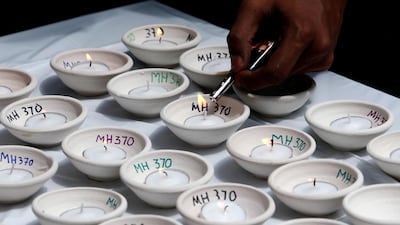Four years ago this Thursday, Malaysia Airlines Flight 370, a Boeing 777 with 239 passengers and crew aboard, was headed for Beijing from Kuala Lumpur. Then 38 minutes after it took off, transmissions ceased. It disappeared from air traffic controllers' radar screens and entered the annals of mystery, heartbreak and despair.
Nobody knows why the plane deviated from its course, whether there was human intervention or not (and if so, what were the roles and motivations of those involved), and where it ended up.
An initial surface search covered millions of sq km, while the largest ever underwater search then combed 120,000 sq km of the southern Indian Ocean, concluding after nearly three years with no sign of a wreck (although small parts did wash up on the coasts of East Africa and islands in the western Indian Ocean).
Still, the Malaysian Government, which has led the biggest non-military effort in history, bringing together 26 countries at one point, has not given up hope. A new search has begun, under a "no find, no fee" arrangement with the US firm Ocean Infinity. Already more than 8000 sq km have been trawled in the first phase of a new three-part survey of the 25,000 sq km which the Australian Transport Safety Bureau's final report identified as being the most likely location in which to find the plane.
Four years on it remains a traumatic, devastating experience for the next of kin who still do not know what happened to their loved ones, still less can they bury them - and for Malaysia, which suffered the downing of another MAS plane, MH17, over Ukraine in July of the same year. For the country's prime minister, Najib Tun Razak, the latter had a personal cost. His step grandmother was on MH17 when it was shot out of the sky. There were no survivors.
The disappearance of MH370 was not made any easier by the inane witterings of the conspiracy theorists who were indulged by a media eager to cover the story but starved of concrete news. Vladimir Putin knew where the plane had gone - the Bay of Bengal - but he wouldn't say so publicly because the information came from a clandestine spy satellite. It had landed in Diego Garcia. "Experts" were said to suspect abduction by a UFO. Bizarre explanations are still being floated to this day, although it is generally accepted that the search is continuing in the right area.
Soon after MH370, Mr Najib made a series of recommendations:
The International Civil Aviation Organisation (ICAO) should introduce real-time tracking. As he observed, in an age of smartphones and mobile internet, “one of the most astonishing things about this tragedy is the revelation that an airliner the size of a Boeing 777 can vanish, almost without a trace.”
He said ICAO should ensure that transponders and Aircraft Communications Addressing and Reporting Systems (ACARS) can’t be disabled mid-air.
He suggested that the location pingers on airplane black boxes should continue to function for at least 90 days, rather than their current 30-day capability, while the black boxes themselves should record not just the final two hours but the whole of any cockpit communication during the flight.
And the emergency location transmitters should be improved so that they work better underwater and last longer than 24 hours.
But progress on these, or indeed any improvements, has been slow. As of 2021, new planes will have to broadcast their location every minute when systems detect that they are in trouble (due to an unexpected change of route or hijacking, for example) – but that doesn’t apply to aircraft currently in service or those introduced in the next three years.
ICAO rules state that all planes must be tracked every 15 minutes as of this November (Malaysian Airlines already meets this requirement), but according to Bloomberg, given how far a commercial jet could fly in that time, in the case of another disappearance that would still leave a possible search zone "the size of Florida".
In the run-up to the anniversary, word is that Mr Najib is urging action to be taken on his recommendations to keep the skies safe, whatever the cost to the airline industry. As he said in the past: "Malaysia will always remember and honour those who were lost on board MH370." And honouring those 239 men, women and children most certainly includes ensuring that such a tragedy could not happen again - because at the moment it could.
This is surely unacceptable. It may be that profit margins for passenger planes are thin, and the cost of installing real time tracking and implementing other necessary measures very high - although in a world of constant scrutiny and where the "internet of things" increasingly appears to be the "internet of everything", it beggars belief that it should be so difficult to keep tabs on jet planes already teeming with electric gadgetry.
But the new search for MH370 is expected to end in June, and while it is believed to be 85 per cent certain that this is the correct area, it is still possible the plane will still not be found.
How, then, could ICAO officials look relatives of the missing in the eye? Expressing remorse for what happened would be hollow. For they have the power to ensure there is no repetition but have failed to do so. They must rectify this, and speedily. After four years, that is the least those who lost loved ones on MH370 deserve.
Sholto Byrnes is a senior fellow at the Institute of Strategic and International Studies Malaysia


